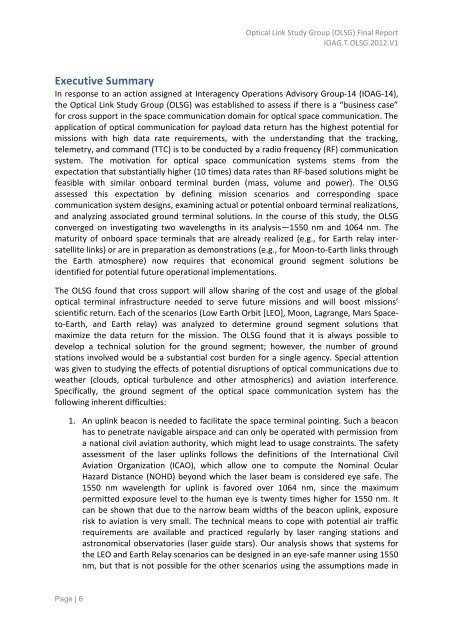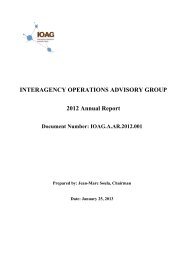OLSG Report_Final_06_05_12 - Interagency Operations Advisory ...
OLSG Report_Final_06_05_12 - Interagency Operations Advisory ...
OLSG Report_Final_06_05_12 - Interagency Operations Advisory ...
Create successful ePaper yourself
Turn your PDF publications into a flip-book with our unique Google optimized e-Paper software.
Optical Link Study Group (<strong>OLSG</strong>) <strong>Final</strong> <strong>Report</strong><br />
IOAG.T.<strong>OLSG</strong>.20<strong>12</strong>.V1<br />
Executive Summary<br />
In response to an action assigned at <strong>Interagency</strong> <strong>Operations</strong> <strong>Advisory</strong> Group-14 (IOAG-14),<br />
the Optical Link Study Group (<strong>OLSG</strong>) was established to assess if there is a “business case”<br />
for cross support in the space communication domain for optical space communication. The<br />
application of optical communication for payload data return has the highest potential for<br />
missions with high data rate requirements, with the understanding that the tracking,<br />
telemetry, and command (TTC) is to be conducted by a radio frequency (RF) communication<br />
system. The motivation for optical space communication systems stems from the<br />
expectation that substantially higher (10 times) data rates than RF-based solutions might be<br />
feasible with similar onboard terminal burden (mass, volume and power). The <strong>OLSG</strong><br />
assessed this expectation by defining mission scenarios and corresponding space<br />
communication system designs, examining actual or potential onboard terminal realizations,<br />
and analyzing associated ground terminal solutions. In the course of this study, the <strong>OLSG</strong><br />
converged on investigating two wavelengths in its analysis—1550 nm and 1<strong>06</strong>4 nm. The<br />
maturity of onboard space terminals that are already realized (e.g., for Earth relay intersatellite<br />
links) or are in preparation as demonstrations (e.g., for Moon-to-Earth links through<br />
the Earth atmosphere) now requires that economical ground segment solutions be<br />
identified for potential future operational implementations.<br />
The <strong>OLSG</strong> found that cross support will allow sharing of the cost and usage of the global<br />
optical terminal infrastructure needed to serve future missions and will boost missions’<br />
scientific return. Each of the scenarios (Low Earth Orbit [LEO], Moon, Lagrange, Mars Spaceto-Earth,<br />
and Earth relay) was analyzed to determine ground segment solutions that<br />
maximize the data return for the mission. The <strong>OLSG</strong> found that it is always possible to<br />
develop a technical solution for the ground segment; however, the number of ground<br />
stations involved would be a substantial cost burden for a single agency. Special attention<br />
was given to studying the effects of potential disruptions of optical communications due to<br />
weather (clouds, optical turbulence and other atmospherics) and aviation interference.<br />
Specifically, the ground segment of the optical space communication system has the<br />
following inherent difficulties:<br />
1. An uplink beacon is needed to facilitate the space terminal pointing. Such a beacon<br />
has to penetrate navigable airspace and can only be operated with permission from<br />
a national civil aviation authority, which might lead to usage constraints. The safety<br />
assessment of the laser uplinks follows the definitions of the International Civil<br />
Aviation Organization (ICAO), which allow one to compute the Nominal Ocular<br />
Hazard Distance (NOHD) beyond which the laser beam is considered eye safe. The<br />
1550 nm wavelength for uplink is favored over 1<strong>06</strong>4 nm, since the maximum<br />
permitted exposure level to the human eye is twenty times higher for 1550 nm. It<br />
can be shown that due to the narrow beam widths of the beacon uplink, exposure<br />
risk to aviation is very small. The technical means to cope with potential air traffic<br />
requirements are available and practiced regularly by laser ranging stations and<br />
astronomical observatories (laser guide stars). Our analysis shows that systems for<br />
the LEO and Earth Relay scenarios can be designed in an eye-safe manner using 1550<br />
nm, but that is not possible for the other scenarios using the assumptions made in<br />
Page | 6



